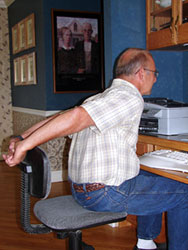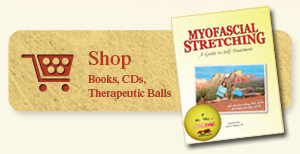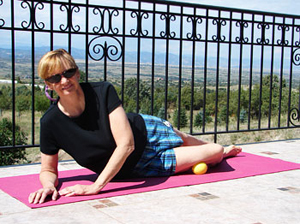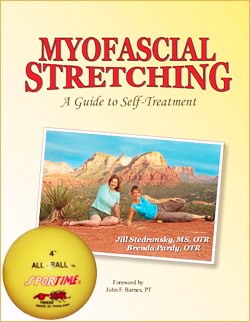Myofascial Stretching:
A Guide to Self-Treatment
is a unique manual of techniques that results in permanent lengthening of the body's connective tissue and dramatically improves health and quality of life.
John F. Barnes, PT, the developer of Myofascial Release, says this of the book:
Jill and Brenda are extraordinary therapists of the highest caliber and have done an excellent job capturing the essence of MFR principles and presenting the stretches with clear photographs and concise explanations. I highly endorse this book for anyone seeking the authentic healing that Myofascial Release has to offer. Go to main website to read entire quote
Myofascial Stretching is an exceptional method of self-treatment based on the principles of Myofascial Release (MFR) as developed by John F. Barnes, PT. The techniques employ sustained pressure using a small inflated ball and active elongation into restrictions in the fascia.
What is Fascia?
Fascia is the tough connective tissue surrounding every cell of the body from head to toe like a three-dimensional spider web. Injury, trauma, inflammation and poor posture cause the fascial system to tighten, putting pressure on nerves, muscles, blood vessels, bones, organs and the brain. This can result in a wide variety of symptoms including pain, restriction of motion, and structural misalignment, impairing both daily function and athletic performance. Releasing the fascia is often considered the missing link for problematic cases of pain and dysfunction.

Myofascial Stretching is great
to do at your desk
How does Myofascial Stretching Differ from Traditional Stretching?
Myofascial Stretching differs from traditional stretching in four primary ways. The first one involves the time element. All stretches, with or without the ball, must be held continuously for a minimum of 90 to 120 seconds before the fascia begins to let go. This results in permanent release of the tissue, as opposed to the temporary results achieved with traditional 30 second stretching. The second major difference is the concept of active elongation. This is what allows one to engage the fascial barrier. The third essential difference is the need to be consciously present throughout the Myofascial Stretching process. It is exponentially more effective when you are able to focus on the tension in the tissue, direct your breath into the restriction, notice the resulting slack as the release takes place, elongate into the next barrier and wait for another release to occur. Regular practice will increase body awareness, and result in improved focus and groundedness. The fourth distinction is that stretching and strengthening occur simultaneously. During active elongation, muscle groups opposing the tight fascia have to contract in a sustained manner. This strengthens them, thereby helping to maintain the elongated state of the tissue just released.

Click here to visit our E-Store

Myofascial Stretching can be done
in a variety of settings
Who was the Book Written For?
Myofascial Stretching was written for the lay person who has chronic pain, muscular tightness and/or postural dysfunction; and also for therapists to use to recommend home exercise programs for their patients. Many therapists and doctors also use the book for themselves. It will benefit most people with pain or tightness. With the help of this book, you can take charge of your own healing. By following the principles of Myofascial Release, you can learn to relieve many of your own aches and pains, muscle tightness and/or poor posture. These things are not necessarily part of the “normal” aging process and maybe you don’t need to ‘just live with it’.

Jill and Brenda stretching
at Red Rocks Park
near Denver
About the Authors
The authors, Jill Stedronsky and Brenda Pardy, are both Occupational Therapists in Denver, Colorado. Many of the techniques were developed while working with clients or engaging in their own self-treatment. Both have utilized Myofascial Stretching to improve the quality of their own lives. Jill used it to overcome 20 years of chronic pain throughout her body, including diagnoses of chronic fatigue syndrome, fibromyalgia and numerous orthopedic conditions. Brenda employs it to treat occasional low back disc pain. Both authors prescribe these stretches regularly to their patients and see more rapid progress because of it.

-
Auto Injuries
-
Back Pain
-
Carpal Tunnel Syndrome
-
Chronic Fatigue Syndrome
-
Elbow, Wrist and Hand Pain
-
Fibromyalgia
-
Headaches
-
Hip Pain
-
Jaw Pain, TMJ Dysfunction
-
Knee, Ankle and Foot Pain
-
Myofascial Pain Syndrome
-
Neck Pain
-
Osteoarthritis
-
Plantar Fascitis
-
Post-Operative and Traumatic Scarring
-
Restriction in Motion
-
Sciatica
-
Scoliosis
-
Shoulder Pain
-
Sports Injuries
-
Stress and Tension Related Problems
-
Thoracic Outlet Syndrome
-
Women’s Health Issues
-
Work Injuries

Click here to visit our E-Store
Back Home








